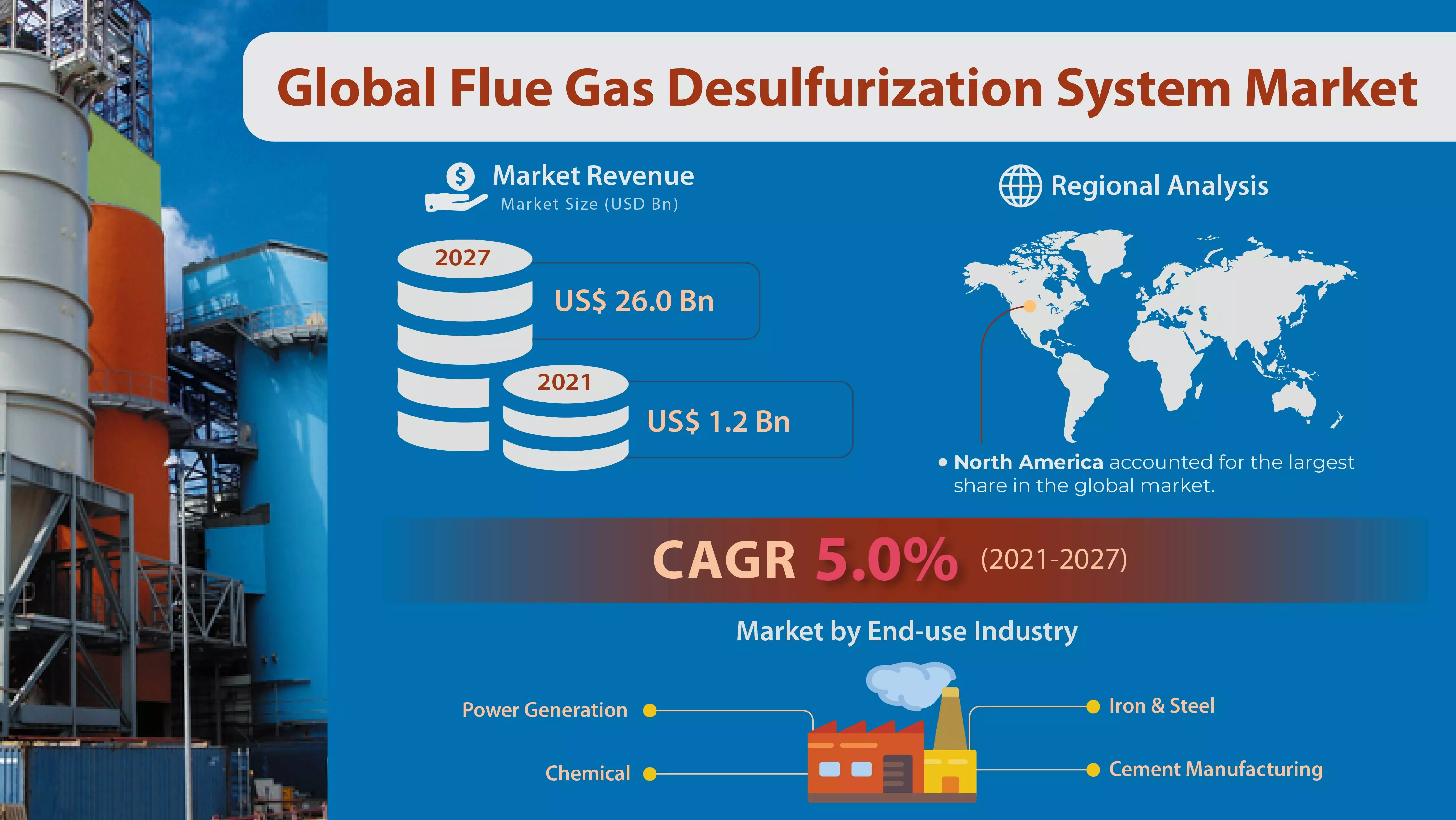Flue Gas Desulfurization System Market (Type - Wet, and Dry & Semi-dry; End-use Industry - Power Generation, Chemical, Iron & Steel, and Cement Manufacturing): Global Industry Analysis, Trends, Size, Share and Forecasts to 2027
A recent report published by
Infinium Global Research on the flue gas desulfurization system market provides an in-depth analysis of segments and sub-segments in the global as well as
regional flue gas desulfurization system market. The study also highlights the
impact of drivers, restraints, and macro indicators on the global and regional
flue gas desulfurization system market over the short term as well as long
term. The report is a comprehensive presentation of trends, forecast and dollar
values of the global flue gas desulfurization system market. According to the
report, the global flue gas desulfurization system market is projected to grow
at a CAGR of 5% over the forecast period of 2021-2027. The market grew from around USD 1.2 billion in 2021 to over USD 26
billion in 2027.

Market Insight
Flue-gas desulfurization (FGD) is
a set of technologies that is been used to remove sulfur dioxide (SO.2.) from
exhaust flue gases of fossil-fuel power plants, and from the emissions of other
sulfur oxide emitting processes such as waste burning. Flue gas desulfurization
systems (FGD) are devices that are capable of sulfur removal efficiencies
between 50% to 98%. The highest removal is achieved by wet scrubbers and the
lowest by dry scrubbers. In many plants, Flue Gas Desulfurization (FGD) Process
is necessary to remove sulfur from the flue gases after the combustion process
to meet environmental requirements. FGD mainly employs two methods of filtering
the emissions (dry or wet scrubbing) for coal-burning plants to be in
compliance with regulations mandated by the EPA’s Effluent Limitation
Guidelines (ELG). FGD processes vary depending upon the amount of SO2 involved
in it, the solution being used to absorb the SO2, and the particular equipment
used in the absorption tower. With the
COVID-19 pandemic, the levels of pollution seen across the globe had decreased
due to various regulations imposed by the governments, businesses, and various
industrial sectors being shut down in order to stop the spread of infectious
diseases people were also restricted from moving out of their houses which in
turn affected economies and industries in various countries. According to the
International Energy Agency, global energy use in 2020 had declined by about
5%, the biggest drop experienced in the past 70 years. This is expected to
burden the revenue path of the global Flue Gas Desulfurization market over the
forecasting years. Due to boundary closure supply chain activities got
disrupted due to which postponement and cancellation of the announced projects
affected its market growth.
The stringent laws for maintaining
the air quality standards imposed by the governments to drive the market growth
in the forecasting period. The high operating costs and initial investments
required by the systems are expected to restrain the flue gas desulfurization
systems market growth in the forecasting years. Moreover, the decreasing number
of coal power plants across the globe might affect the market growth of the
flue gas desulfurization systems market during the forecast period. The
Increasing number of coal-fired power plants in Asia Pacific countries will
provide an opportunity for its market growth. The highest increase in the usage
of coal for power generation in countries such as India, and China, while
consumption patterns decreased in North America and Europe region over the past few
years.
Among the regions, Asia Pacific
accounted for the largest share in the global Flue Gas Desulfurization System
Market. Owing to demand from the power generation industry as a result of the
increased regulations and power production in the region will propel its market
growth. The cement and metal smelting industries, as well as the chemical
sector, are growing in the Asia Pacific creating opportunities for market
growth in this region. However, the Asia Pacific region is anticipated to grow
at the highest rate in the global Flue Gas Desulfurization System Market over
the forecast period. Factors driving the market growth include increasing
demand from the power & energy sector and stringent rules and regulations
imposed by the government. However, the high cost of reagents and safety
concerns related to the FGD System are likely to put a negative impact on the
market growth in the forecasting years.
Segment Covered
The report on the global flue gas
desulfurization system market covers segments such as type, and end-use
industry. On the basis of type, the sub-markets include wet, and dry &
semi-dry. On the basis of end-use industry, the sub-markets include power generation,
chemical, iron & steel, and cement manufacturing.
Companies Profiled:
The report provides profiles of
the companies in the market such as Mitsubishi Heavy Industries Ltd, General
Electric Company, Doosan Lentjes, Babcock & Wilcox Enterprises Inc, Rafako
S.A, Thermax Ltd, Koch-Glitsch, KraftPowercon, Ducon Technologies Inc, and
Burns & McDonnell.
Report Highlights:
The report provides deep insights into the demand forecasts, market trends, and micro and macro indicators. In addition, this report provides insights into the factors that are driving and restraining the growth in this market. Moreover, The IGR-Growth Matrix analysis given in the report brings an insight into the investment areas that existing or new market players can consider. The report provides insights into the market using analytical tools such as Porter's five forces analysis and DRO analysis of the flue gas desulfurization system market. Moreover, the study highlights current market trends and provides forecast from 2021-2027. We also have highlighted future trends in the market that will affect the demand during the forecast period. Moreover, the competitive analysis given in each regional market brings an insight into the market share of the leading players.
